It's a Neolissochilus sp. From Thai probably either variants of stracheyi or soroides
Mahseer, Tor, and Neolissochilus at Fish Story
- Thread starter thebiggerthebetter
- Start date
You are using an out of date browser. It may not display this or other websites correctly.
You should upgrade or use an alternative browser.
You should upgrade or use an alternative browser.
Thank you for that, except I don't know which fish you are referring to.It's a Neolissochilus sp. From Thai probably either variants of stracheyi or soroides
If the OP fish, then are you challenging the Tor douronensis ID of Antzzom Lee from YouTube?
If the small recent acquisition from Rapps, then are you challenging its ID as Tor douronensis?
Or both?
Please be clear and not so curt as to the point of confusing me. I am confused enough and the mahseer wretched state of taxonomy is not helping either...
Thank you for that, except I don't know which fish you are referring to.
If the OP fish, then are you challenging the Tor douronensis ID of Antzzom Lee from YouTube?
If the small recent acquisition from Rapps, then are you challenging its ID as Tor douronensis?
Or both?
Please be clear and not so curt as to the point of confusing me. I am confused enough and the mahseer wretched state of taxonomy is not helping either...
Both, in the 4500g & the smaller specimen. Tor have sharper snout, have higher scales on the dorsal fin, different body type (but yours too fat for it to be distinguishable). I'm a dealer of these mahseers, seen plenty of specimens that I'm starting to see the differences.
Tor douronensis identification are still pending or even valid at this point. All 3 species; tambroides, tambra & douronensis are considered as the same species, since the Tambra are the senior synonym, all of these mahseer are considered T. tambra unless further study of the douronensis was done in holotype locality, Sumatra.
Mike ShookONES kindly sold his mahseer collection to us.
Tor tambra 2x, 10"-11"
Tor sinensis 1x, 13"
Tor putitora 1x, 8"
Neolissochilus benasi 1x, 7"
Tor malabaricus 2x, 6"
Tor tambroides 2x, 4"
Spinibarbus hollandi 1x, 4"
and step by step the biggest have gone into the 25K cyprinid exhibit:
2 Chinese
2x Tambra and 1x putitora
Mahseer in the minnow 240 gal, 20:20-22:30 minutes:
Tor tambra 2x, 10"-11"
Tor sinensis 1x, 13"
Tor putitora 1x, 8"
Neolissochilus benasi 1x, 7"
Tor malabaricus 2x, 6"
Tor tambroides 2x, 4"
Spinibarbus hollandi 1x, 4"
and step by step the biggest have gone into the 25K cyprinid exhibit:
2 Chinese
2x Tambra and 1x putitora
Mahseer in the minnow 240 gal, 20:20-22:30 minutes:
We have lost the benasi we bought from Wes (the one from Mike ShookONES is doing well), IDK why, no good reason, still was small, still in the minnow growout 240 gal; was stressed probably with some latent /internal illness, got pale, this went on for a few weeks and then it passed at 7"; it was rasped by two 20" plecos post-mortem, hence the missing scales...:


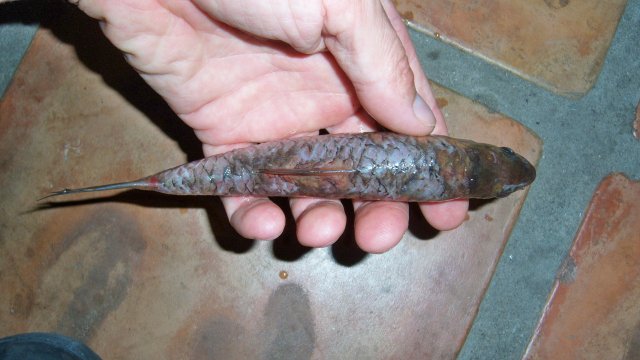

* * * * * * *
We have seen strikingly colored blue stracheyi before:
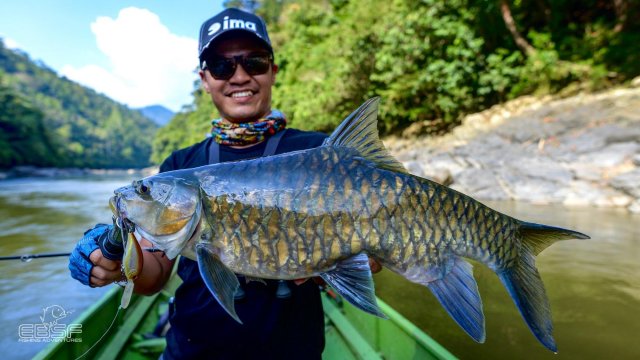
... but Wesley Wong of Rare Fish often wrote in his sales threads of some mahseers having some fabulous colors... yet seeing is believing. I stumbled across this scientific article with unbelievably beautifully colored Chinese and Tambra mahseer: https://lkcnhm.nus.edu.sg/app/uploads/2017/06/47rbz225-236.pdf
Too bad we'll probably never be able to replicate such colors in captivity but they are indeed breathtaking:
Tor sinensis, 1.5 feet:
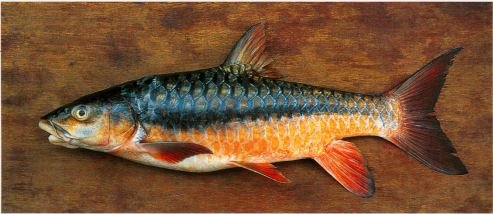
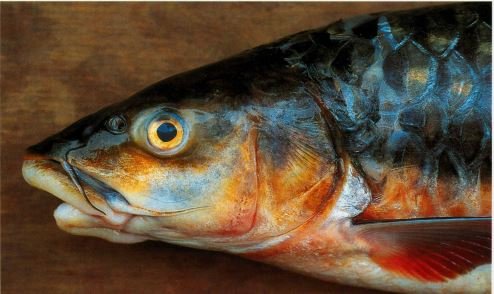
Tor tambra, male, 3 feet 4 inches:
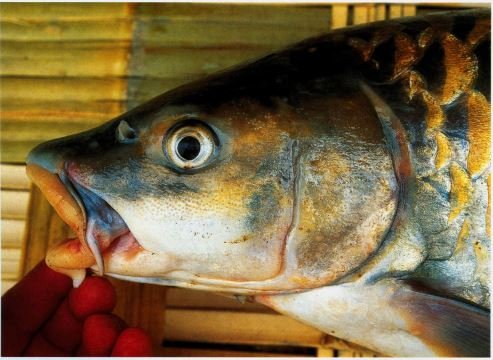
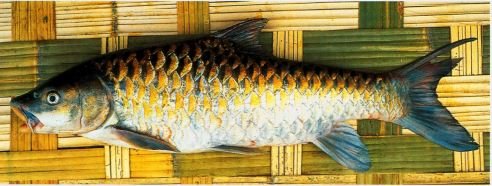




* * * * * * *
We have seen strikingly colored blue stracheyi before:

... but Wesley Wong of Rare Fish often wrote in his sales threads of some mahseers having some fabulous colors... yet seeing is believing. I stumbled across this scientific article with unbelievably beautifully colored Chinese and Tambra mahseer: https://lkcnhm.nus.edu.sg/app/uploads/2017/06/47rbz225-236.pdf
Too bad we'll probably never be able to replicate such colors in captivity but they are indeed breathtaking:
Tor sinensis, 1.5 feet:


Tor tambra, male, 3 feet 4 inches:


Out of the blue, pun intended, we lost our Tor khudree this morning, the one Wes transferred to us in Aug 2015. You can see why it is called a blue tail mahseer in the pics below. It's always been a food hog and this may be in part why it didn't last longer, albeit IDK for how long Wes had had it before. I can't imagine more than 5-10 years but likely less, a lot less.
 fugupuff
?
fugupuff
?
It lived in a 4500 gal for the first 3.5 years with us and in 25,000 gal for the last 1.5.
It arrived from California already large, at around 22" and added 5 more inches in 5 years with us to reach 27". It gained an obscene mass and girth and felt about 15-20 lbs when I held it. It was an indiscriminate eater sucking up everything in its path.
Thus, it has eaten a lot of low quality, cheap, mostly-wheat-bean-and-corn Zeigler pellets (I only switched to NLS a couple of months ago) and was badly overfed probably, as I have recently learned better with the help of RD.
RD.
 duanes
and
F
fishdance
.
duanes
and
F
fishdance
.
 kendragon
- what do you think cyprinid Sensei-san? That's an Indian fish, right,
kendragon
- what do you think cyprinid Sensei-san? That's an Indian fish, right,
 headbanger_jib
Jibran?
headbanger_jib
Jibran?
If I look back now, I'd say it has not been its normal self for the last few months, feeding less and sometimes not coming to the feedings at all though I thought I was merely missing it... now I think I wasn't, it just wasn't there at the feedings. Other than that, nothing else looked wrong, it remained as beautiful, thick, sleek, and well-groomed and as ever.
I didn't cut it open as I used to do for almost every fish. Somehow found no motivation, it's messy and gruesome and I rarely learn much... Probably I should have anyway but with so many recent deaths, I guess it is getting to me a bit and I have given up on post mortem exam altogether... I am sure there'd be a lot of fat inside but who knows... Just buried it under our mango tree. Poured ammonia on it so the coyotes don't dig it up in the night, or vultures in the day...
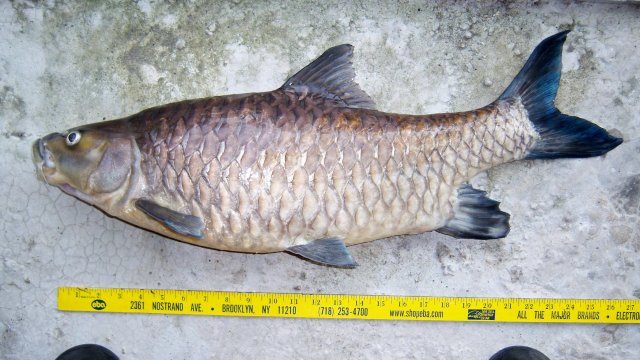
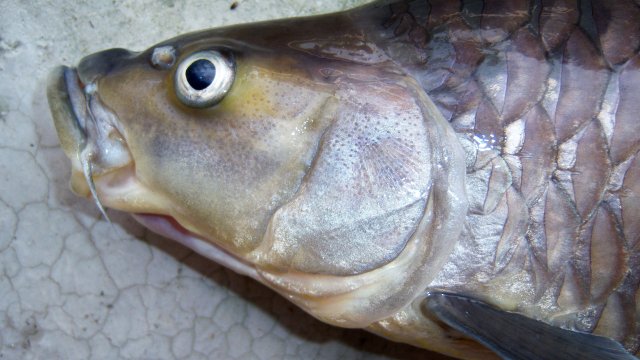
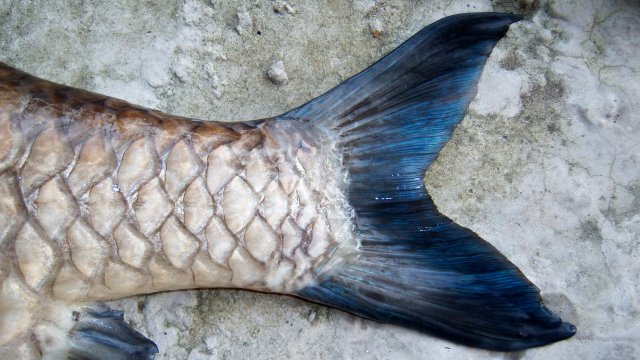
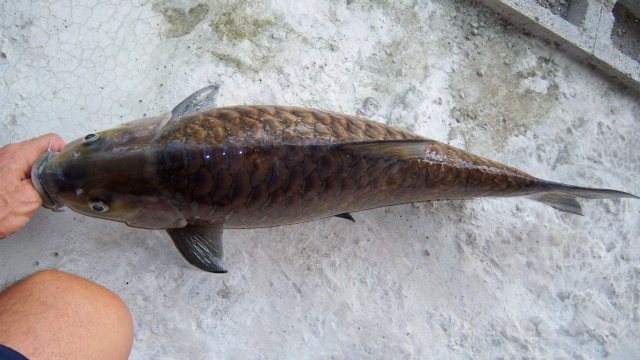
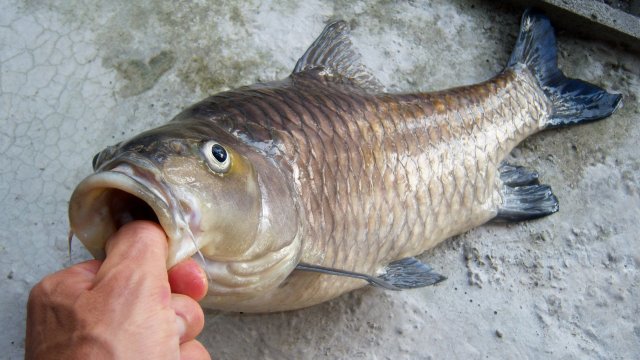
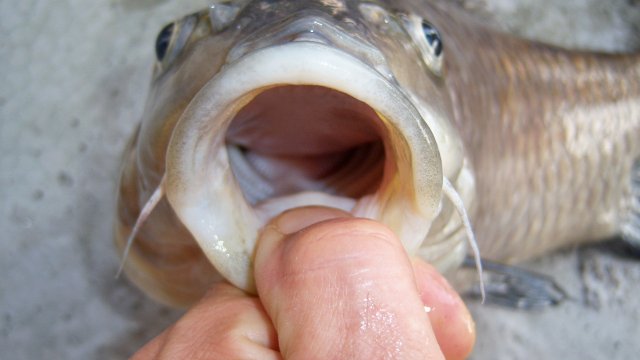
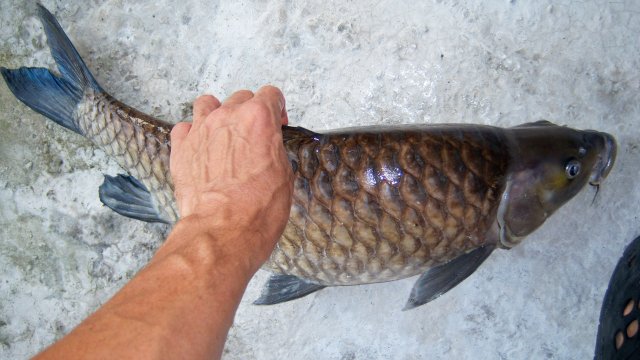
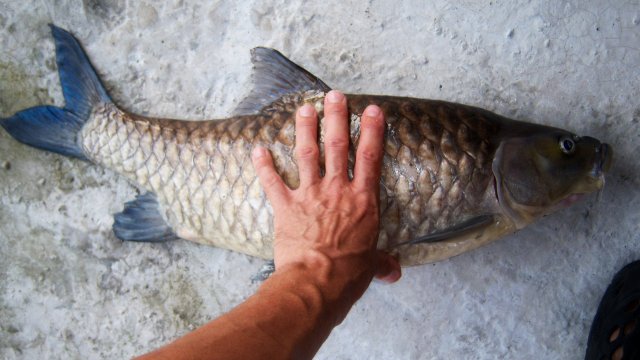
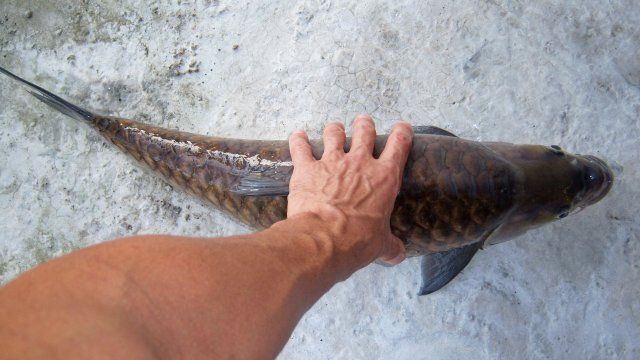
It lived in a 4500 gal for the first 3.5 years with us and in 25,000 gal for the last 1.5.
It arrived from California already large, at around 22" and added 5 more inches in 5 years with us to reach 27". It gained an obscene mass and girth and felt about 15-20 lbs when I held it. It was an indiscriminate eater sucking up everything in its path.
Thus, it has eaten a lot of low quality, cheap, mostly-wheat-bean-and-corn Zeigler pellets (I only switched to NLS a couple of months ago) and was badly overfed probably, as I have recently learned better with the help of
If I look back now, I'd say it has not been its normal self for the last few months, feeding less and sometimes not coming to the feedings at all though I thought I was merely missing it... now I think I wasn't, it just wasn't there at the feedings. Other than that, nothing else looked wrong, it remained as beautiful, thick, sleek, and well-groomed and as ever.
I didn't cut it open as I used to do for almost every fish. Somehow found no motivation, it's messy and gruesome and I rarely learn much... Probably I should have anyway but with so many recent deaths, I guess it is getting to me a bit and I have given up on post mortem exam altogether... I am sure there'd be a lot of fat inside but who knows... Just buried it under our mango tree. Poured ammonia on it so the coyotes don't dig it up in the night, or vultures in the day...









Well Viktor he certainly didn't die from skinny disease! Sorry to see you lose a fish amigo. Is there by chance any schools near by you that would consider performing necropsies on any possible future fish as a learning tool for their students?
Sorry to see this one go.Out of the blue, pun intended, we lost our Tor khudree this morning, the one Wes transferred to us in Aug 2015. You can see why it is called a blue tail mahseer in the pics below. It's always been a food hog and this may be in part why it didn't last longer, albeit IDK for how long Wes had had it before. I can't imagine more than 5-10 years but likely less, a lot less.fugupuff ?
It lived in a 4500 gal for the first 3.5 years with us and in 25,000 gal for the last 1.5.
It arrived from California already large, at around 22" and added 5 more inches in 5 years with us to reach 27". It gained an obscene mass and girth and felt about 15-20 lbs when I held it. It was an indiscriminate eater sucking up everything in its path.
Thus, it has eaten a lot of low quality, cheap, mostly-wheat-bean-and-corn Zeigler pellets (I only switched to NLS a couple of months ago) and was badly overfed probably, as I have recently learned better with the help ofRD.
duanes and F fishdance .
kendragon - what do you think cyprinid Sensei-san? That's an Indian fish, right,
headbanger_jib Jibran?
If I look back now, I'd say it has not been its normal self for the last few months, feeding less and sometimes not coming to the feedings at all though I thought I was merely missing it... now I think I wasn't, it just wasn't there at the feedings. Other than that, nothing else looked wrong, it remained as beautiful, thick, sleek, and well-groomed and as ever.
I didn't cut it open as I used to do for almost every fish. Somehow found no motivation, it's messy and gruesome and I rarely learn much... Probably I should have anyway but with so many recent deaths, I guess it is getting to me a bit and I have given up on post mortem exam altogether... I am sure there'd be a lot of fat inside but who knows... Just buried it under our mango tree. Poured ammonia on it so the coyotes don't dig it up in the night, or vultures in the day...
View attachment 1413325View attachment 1413326View attachment 1413327View attachment 1413328View attachment 1413329View attachment 1413330View attachment 1413331View attachment 1413332View attachment 1413333
The tor khudree do have a voracious appetite, and yes they're from india.
Well Viktor he certainly didn't die from skinny disease! Sorry to see you lose a fish amigo. Is there by chance any schools near by you that would consider performing necropsies on any possible future fish as a learning tool for their students?
Thank you, Neil. Turns out I should have heeded more than just the advices on the quality but also on the quantity.
Yeah, that could be a really win-win scenario. I'll look around. There are some universities in the area with programs in biology. I've almost done it once with one professor. He is Lycosid on Planet Catfish. But he couldn't find a way to ship quickly enough plus my wife all of a sudden presented a huge and vocal objection, along the lines what if we get caught shipping dead fish illegally (via UPS or FedEx), what if his students catch something from the dead fish, etc., the usual the sky may fall fiction but my domestic bliss is not worth it, so it never happened. That was about a 3' Asian RTC.
Thank you, Jib. Yes, this fish was an eating machine, unstoppable, unfillable.Sorry to see this one go.
The tor khudree do have a voracious appetite, and yes they're from india.
Firstly, I'm sorry to hear of your Tor Khudree loss. He has lived well, if you can accept that as a consolation.
If I may continue, this is exactly what I'm trying to replicate in one of my next tank in progress. The star of the tank will be Thai blue mahseers (Neolissochilus Stracheyi). Oh, btw, I did some homework on observing the fishes that are on sale, asking anglers who are fly fishing for mahseer in Thailand) for their valuable inputs, I'm betting heavily that the nicest looking Stracheyi will be from North East Thailand at either the tributary rivers to Salween river or from Salween herself.
Stracheyi are available in most Thai river systems and neighbouring countries too. The Mekong, Chao Phraya and Salween among them, and angler friends mentioned the same too that those from Salween has a very noticeable brighter and fuller colouration to their scales. So, I'm trying my best to mimic the water chemistry there, even using sand substrate from Salween too. Bought everything, just need to plug in the chiller (might as well go all the way with seasonal water temperature too, lol). And the fish itself which is going to be impossible since Thailand extended their lockdown to 31st May. When the fish do arrive, I'll try to see if the incredibly beautiful gold & blue colours of the Stracheyi can be mostly retained with all the reading of papers on water chemistry of River Salween. If it's a failure, then the good people here can learn from my mistakes. I am here to be corrected.
Oh yeah, on the ID of Tor Douronensis, I will think it will be an extremely tall order to ID conclusively. And I think the main reason is that Tor Douronensis now calls few countries home and all their homes are now all isolated from what I would believe was the main waterway used to spread to Malaysia, Thailand, Vietnam and beyond. It would make sense that Tor Douronensis spread to south-east of South East Asia during the Pleistocene period probably through what is now still Mekong river when almost the whole of South East Asia is one giant piece of land (The Sundaland) when sea levels receded dramatically not too long ago by planet standards. So, these new Tor Douronensis will likely display their own morphing (For eg. If I were to use the Thai translation, it will be an either red or bluish fish on Google, and I was offered fish with the same Thai name which looks very dark blue to almost black but similar body shape as the Tor Tambra). The Pleistocene is also the reason why the east coast of peninsula Malaysia has natural Jullien's Golden Carp but not the west coast, the other side of a mountain range.
While I noticed mahseer of the Neolissochilus sp are perhaps more colourful, I guess the species should take second place after the beauty of the individual fish itself....
Cheers, my friend.
Too bad we'll probably never be able to replicate such colors in captivity but they are indeed breathtaking
If I may continue, this is exactly what I'm trying to replicate in one of my next tank in progress. The star of the tank will be Thai blue mahseers (Neolissochilus Stracheyi). Oh, btw, I did some homework on observing the fishes that are on sale, asking anglers who are fly fishing for mahseer in Thailand) for their valuable inputs, I'm betting heavily that the nicest looking Stracheyi will be from North East Thailand at either the tributary rivers to Salween river or from Salween herself.
Stracheyi are available in most Thai river systems and neighbouring countries too. The Mekong, Chao Phraya and Salween among them, and angler friends mentioned the same too that those from Salween has a very noticeable brighter and fuller colouration to their scales. So, I'm trying my best to mimic the water chemistry there, even using sand substrate from Salween too. Bought everything, just need to plug in the chiller (might as well go all the way with seasonal water temperature too, lol). And the fish itself which is going to be impossible since Thailand extended their lockdown to 31st May. When the fish do arrive, I'll try to see if the incredibly beautiful gold & blue colours of the Stracheyi can be mostly retained with all the reading of papers on water chemistry of River Salween. If it's a failure, then the good people here can learn from my mistakes. I am here to be corrected.
Oh yeah, on the ID of Tor Douronensis, I will think it will be an extremely tall order to ID conclusively. And I think the main reason is that Tor Douronensis now calls few countries home and all their homes are now all isolated from what I would believe was the main waterway used to spread to Malaysia, Thailand, Vietnam and beyond. It would make sense that Tor Douronensis spread to south-east of South East Asia during the Pleistocene period probably through what is now still Mekong river when almost the whole of South East Asia is one giant piece of land (The Sundaland) when sea levels receded dramatically not too long ago by planet standards. So, these new Tor Douronensis will likely display their own morphing (For eg. If I were to use the Thai translation, it will be an either red or bluish fish on Google, and I was offered fish with the same Thai name which looks very dark blue to almost black but similar body shape as the Tor Tambra). The Pleistocene is also the reason why the east coast of peninsula Malaysia has natural Jullien's Golden Carp but not the west coast, the other side of a mountain range.
While I noticed mahseer of the Neolissochilus sp are perhaps more colourful, I guess the species should take second place after the beauty of the individual fish itself....
Cheers, my friend.


